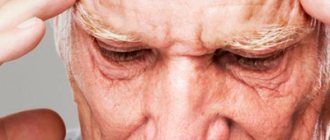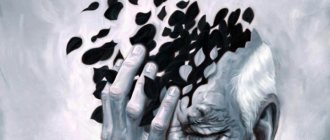Dementia is colloquially referred to as acquired dementia acquired during life rather than at birth. It more often affects people of mature age and is associated with damage to the brain structure.
The disease usually develops in one of two directions: atrophic or vascular. There are also mixed forms that combine both options.
Atrophic dementia is associated with the destruction of brain tissue and accounts for the largest percentage of cases. This includes the well-known Alzheimer's disease, as well as Pick's disease, Huntington's chorea, etc.
Vascular dementia develops against the background of “spoiled” cerebral circulation and accounts for approximately 15% of all dementors. It occurs with a variety of symptoms, which depends on the location of the pathological process, the area of the lesion and the caliber of the affected line.
Causes and essence of the disease
Vascular dementia develops due to disruption or cessation of blood circulation in one of the brain areas, as a result of which some brain cells die. The rate of progression of the process and the severity of symptoms will depend on how quickly the provoking factor acts.
Acute development of pathology is observed with stroke, ischemic or hemorrhagic. In the case of an ischemic stroke, a blood line is blocked by a thrombus. Its hemorrhagic form is characterized by rupture of the vessel. Both phenomena interfere with blood supply, which leads to irreversible death of cells in the brain area.
Typically, vascular dementia occurs in 25% of stroke patients. This happens if 50 ml of brain tissue is affected. The area and affected area play a big role. However, there are particularly sensitive areas of the brain, where even the slightest destruction entails disastrous consequences. These are, for example, the frontal lobes, visual hillocks.
For patients with vascular dementia, there is such a pattern: the first symptoms can appear either immediately after a stroke, or delayed, within six months. A period of 6 months is an indicative sign of vascular dementia. Typically, a stroke, especially a hemorrhagic one, leads to a rapid development of events, the appearance and increase of symptoms.
In a chronic destructive process, when small vessels are damaged, brain cell atrophy occurs gradually. Its compensatory mechanisms are activated, and symptoms increase gradually. The first signs are difficult to identify. Sometimes they hide not only from others, but also from the patient himself.
The main provoking factor that causes disruption of the patency and integrity of the blood network in the brain is atherosclerosis, that is, the deposition of sclerotic plaques on the vascular walls. Other reasons include:
- heart disease, cardiovascular failure;
- arterial hypertension;
- arterial hypotension;
- vasculitis – inflammation of the vessel wall;
- diabetes;
- hyperlipidemia;
- lack of estrogen;
- bad habits;
- excess body weight.
Treatment
As a rule, with vascular psychosis, self-care skills and daily activities are preserved, so hospitalization is not necessary. However, our clinic has a comfortable hospital, equipped in accordance with international standards, where there is everything necessary for long-term stay of patients. We guarantee round-the-clock supervision, politeness and tact of medical personnel, which is very important when treating older people.
The main attention is paid to the treatment of the underlying disease and restoration of blood circulation . Psychotropic drugs are prescribed according to strict indications due to the risk of complications and adverse reactions. Preference is given to “mild” tranquilizers that have a sedative effect. Neuroleptics are used in minimal dosages . For severe depressive symptoms, antidepressants are indicated. Additionally, the doctor must prescribe general health-improving medications (vitamins, nootropics, etc.). They recommend a diet correction with the exception of fatty and fried foods, a complete cessation of bad habits (alcohol, smoking), adherence to a daily routine (full sleep, work according to a strict schedule). It is important to limit the influence of stress factors.
If you have any questions, call us at 8(969)060-93-93 around the clock. Our operator will connect you with a specialist for a preliminary consultation, make an appointment or arrange a doctor’s home call.
General groups of symptoms
The disease distinguishes two groups of disorders: cognitive and neurological.
Cognitive disorders come to the fore, that is, regression of cognitive and thinking functions.
At the initial stage of the disease, memory is primarily affected. At first these are subtle changes. A person forgets some events, individual names and dates, and cannot find the right word to express a thought. The process of assimilation of new knowledge worsens, and it becomes increasingly difficult for the patient to remember and analyze new information.
Gradually, amnestic symptoms increase. The person does not grasp the meaning of what was said, and it becomes more and more difficult to find words. Because of this, his speech becomes meager, his sentences are short and monosyllabic. If talkativeness manifests itself, then it is incoherent; letters in words can be rearranged, words can be replaced. The person himself does not understand the meaning of what he said. Speech impairment leads to difficulties with writing and reading.
Amnesia occurs in the following forms:
- progressive - the patient begins to forget what happened to him recently, and then earlier events;
- fixation – inability to perceive, analyze, store new material, current events. Consciousness in such patients is preserved; they remember well the events of the past, but cannot remember what they talked about with the person 5 minutes ago. Having bought milk, brought it home and put it in the refrigerator, a few minutes later they are going to the store again to buy it, since they have already forgotten that they purchased it;
- Paramnesia is false memories when the patient supplements reality with unreal events. For example, he may pass off as reality events read in a book or seen in a film, and believe that this actually happened to him. Or he simply fantasizes, passing off as reality what did not happen. It is possible that events may shift in time, that is, what happened many years ago is perceived by a person as having happened yesterday.
In addition to memory, other cognitive functions are affected in vascular dementia. Attention is scattered, it is impossible to fix it for a long time. Perception is disrupted. Thinking becomes inflexible. It is difficult to switch from one activity to another.
Often, as the process progresses, patients develop a symptom such as Korsakoff's syndrome, named after the doctor who first described it. It combines several symptoms. First of all, this is fixation amnesia. As already mentioned, the patient does not remember current events, but retains memory of the past. In this regard, he loses orientation in time and space. So-called amnestic disorientation develops.
There are also various variations of paramnesia: doubts about the occurrence of a particular event, their displacement in time, a mixture of fictional and true events.
Against this background, a person gets lost in an unfamiliar environment. He doesn't understand where he is. While in the hospital, he cannot find his bed, but in a familiar environment, at home, he finds his way around perfectly.
How are mental disorders treated in older people?
Successful treatment of age-related mental disorders depends on the type and stage of the disease observed.
Functional mental disorders that do not lead to dementia can be treated quite successfully. They are reversible, and therefore amenable to drug therapy with the prescription of sedatives, drugs that reduce anxiety, and antidepressants.
The situation is much more complicated with organic irreversible mental diseases. They are not being treated. Nevertheless, there are various psychotherapeutic methods and medications that allow long-term maintenance of the proper quality of life of an elderly patient while maintaining consciousness and cognitive functions.
Neurological disorders
In the initial stage of the disease, neurological dysfunctions manifest themselves as general symptoms. Weakness and fatigue, absent-mindedness, and irritability appear. I am bothered by systematic headaches and sleep is disturbed. There is an unstable emotional background. Depressive states are possible. The person is unrestrained, hot-tempered, and embittered. Emotional incontinence usually manifests itself in violent crying or laughter, weakness.
Among other neurological indicators, cerebellar syndrome occurs, characterized by uncoordinated movements. It seems that the arms and legs are moving chaotically. Because of this, the gait changes: it becomes shaky, slack. The person appears to be drunk. Instability of the step provokes falls.
The disease causes accentuation of personality traits. For example, if previously a person was scrupulous and meticulous, then pathology turns him into a picky grumbler.
Pseudobulbar syndrome is expressed by a triad of signs:
- dysarthria - pronunciation disorder;
- dysphonia – loss of voice sonority;
- dysphagia – problems with swallowing.
There are cases of paralysis and paresis, but quite rarely. Muscle tone and reflexes are increased.
Quite often, malfunctions in the functioning of the pelvic organs occur, and epileptic seizures occur.
In general, dementia of vascular origin is characterized by narrowness and fixation of mental processes, loss of flexibility of thinking, fading of cognitive abilities, and a narrow range of interests.
Causes of mental disorders in older people
Elderly people rarely boast good health. It is quite obvious that chronic diseases accumulated over a lifetime and the natural aging of the body contribute to a decrease in mental potential.
Poor mental health is aggravated by stress, fears, and negative thoughts. For any nervous system, prolonged overstrain is fraught with the occurrence of mental disorders. The psyche of the elderly is the most vulnerable, undermined by illnesses and physical disabilities.
Cases of vascular dementia
Scientists have established for certain that the Russian writer, imperial maid of honor Smirnova Alexandra Osipovna, whom A.S. once admired. Pushkin, suffered from vascular dementia.
From her youth, she was distinguished by her gloomy mood or its swings, insomnia. At the age of 40, she suddenly lost weight and became haggard. I didn’t want to see doctors. She was treated on her own: sermons, rituals. Her heredity was burdened with mental disorders.
At the age of 69, her condition worsened further. Her speech became incoherent, she rearranged syllables in words and distorted them. Memory suffered and behavior was disrupted. The mental state deteriorated sharply, reaching the level of mental disorder.
According to data collected from eyewitnesses, Alexandra Osipovna was diagnosed with “atherosclerotic dementia.”
Another famous writer, the author of Uncle Tom's Cabin, Harriet Beecher Stowe, was also diagnosed with vascular dementia. She devoted her entire life to caring for her large family, fighting poverty and disease. In the last years of her life, after the death of her husband, Harriet lived completely alone. She exhibited strange behavior. Sometimes she came to Twain’s house and wandered around the rooms there. She didn’t pay attention to anyone, she was aloof. After walking around a bit among the people, she returned home. Her mental abilities had completely deteriorated, she practically could not take care of herself. The patient's memory underwent special destructive changes.
Origin of mental disorders in older people
Aging of the body is inevitably accompanied by suppression of vital functions.
A person not only weakens physically, but also loses mental potential. Of course, among pensioners there will always be energetic optimists who set an example of a positive attitude towards life. They are strong in spirit, control their will, are ready to radically change their lives at any moment, and stimulate others with their energy. But such old people, unfortunately, are few and far between. For the most part, older people do not resist aging and loss of strength. They live in the past, finding solace in it, and do not want to see prospects. They often concentrate on thoughts about illness and imminent death, which further increases the level of anxiety and ultimately provokes age-related mental disorders. Mental illnesses in older people are represented by two groups:
- Functional (reversible) – not causing dementia;
- Organic – irreversible changes accompanied by loss of memory and self.
Consultations
Psychiatrist
Psychotherapist
Family psychotherapy
Forms of vascular dementia
The brain provides us with conscious existence, being responsible for mental, emotional, and adaptive processes. Its substance is strictly structured. Each of its departments is responsible for its functions.
However, any part of the brain can undergo destructive changes, as a result of which a certain type of activity is disrupted. Based on this, several forms of the disease are distinguished, differing not only in location, but also in the caliber of the affected vessels.
Dysmnestic or lacunar dementia occurs against the background of destruction of small-diameter vessels. As a result, multiple infarct foci appear in the thickness of the white and gray matter. This is the most classic variant of the course of the disease, in which all pathological manifestations are not clearly expressed. There is a measured decrease in intellectual abilities, mild memory impairment, and slight slowness of psychomotor skills.
The multi-infarction form is accompanied by damage to vessels of medium diameter, and usually develops in non-acute pathological processes. Its manifestations are insignificant and go unnoticed for a long time even by the patient himself. Its course is gradual. The disorders first progress and then freeze at a certain stage until the next micro-stroke. Among the symptoms of this type of disease, cognitive impairment comes to the fore. Neurological and emotional disorders gradually develop.
Subcortical vascular dementia is a disease of small vessels, against which atrophy of white matter cells occurs with the formation of ischemic areas. Scientists see the reason for this process in the accumulation of amyloid in the walls of the arteries, followed by its inflammation. The clinical picture of the disease is somewhat atypical. It can occur as Alzheimer's disease or as isolated dementia.
Autoimmune vasculitis, such as systemic lupus erythematosus and panarteritis, cause another form of the disease - cerebral vasculitis. It is expressed by dementia and confusion. As a rule, it affects patients over 50.
Mixed dementia combines two forms: vascular and atrophic, that is, Alzheimer's type. Therefore, in the picture of the disease one can observe symptoms of both vascular dementia and Alzheimer's disease, but the latter prevail over the former.
Advantages of treatment in our clinic
- We treat anonymously
. We do not register with government control authorities. We store patient data only in the clinic’s closed archive. - We inform you about treatment methods
. We inform relatives how we are treating the patient. If necessary, we describe in detail the treatment methods, their results, and possible complications. - We place you in a hospital
. We urgently hospitalize patients who do not control their actions and are dangerous to themselves and others. We monitor them during treatment and ensure their safety. - We provide support after treatment
. We provide contacts for psychologists and psychiatrists at the clinic. We provide consultations after completing the course of treatment.
Call us, we will help you or your loved ones get rid of psychosis.
Binswanger's disease
The pathology is named after its discoverer and is subcortical atherosclerotic encephalopathy. Develops as a result of damage to small cerebral vessels and is a fairly common form of dementia: about 1/3 of all dementors.
It has been established that arterial hypertension plays a major role in the development of pathology. It was observed in 80% of patients with this form. Most often, the disease starts after 50 years and begins suddenly. The first signs of it may be a transient disturbance of cerebral circulation, accompanied by sudden paralysis, which, however, also suddenly disappears. Other signs include small strokes and parkinsonism. A magnetic gait is observed when the legs seem to stick to the floor.
Emotional incontinence appears in the form of sudden laughter or crying, speech is impaired, and control over vital functions (for example, urination) is lost. Problems with memory and thinking appear already at the beginning of the disease.
The symptoms of the pathology are quite varied. After all, the process causes extensive damage to brain tissue with ischemia, destruction of nerve cell processes, and demyelination of nerve fibers. The process is accompanied by steady progression, although cases of persistent remission are possible.
Delusional disorder symptoms and classification
In clinical practice, a psychiatrist always defines the type of pathological ideas that take possession of a person. This helps him to guess the cause of the disorder and clarify the right direction in providing assistance.
Depending on the main idea, there are three large groups of types of delusions: paranoid, delusions of grandeur and depressive. With the paranoid variant, a person is firmly convinced that he is being adversely affected. This type includes:
- Delusion of persecution (persecutory). A person believes that he is being stalked or watched. The patient is sure that there is a whole conspiracy theory against him to cause him harm. As a result, neighbors, friends, relatives, and workmates fall under his suspicion.
- Delirium of damage. A person is sure that someone is deliberately damaging or stealing his things. Usually he thinks badly of those who come into contact with him in everyday life.
- Delusional relationship. The entire surrounding reality, according to the patient, is directly related to him. This includes any words, actions, conversations of others.
- Delirium of influence. A person suffering from this pathology is sure that he is being influenced with the help of various devices, radiation, and psychically.
- Delirium of jealousy. Most often it manifests itself in men as an obsession with the personality of their partner. He is imbued with the idea of infidelity, accompanied by aggressive actions. This deviation is somewhat less common in women and is characterized by attacks of aggression and psychosis. The most common provoking factor in the development of the disorder is chronic alcoholism.
- Delirium of intermetamorphosis, or staging. A person tells everyone that everyone around him is performing pre-arranged actions, like a performance, intended only for him.
- Paraphrenic. There is a combination of several types of delusions, such as grandiosity and persecution.
Delusions of grandeur include the following varieties:
- Delirium of origin. It lies in the conviction of one’s noble origin.
- Invention. It is accompanied by active actions - visits to various authorities and institutions to implement unrealistic projects, which the patient himself considers to be the greatest inventions important for humanity.
- Delirium of eternal life. Confidence in one's own immortality.
- Delirium of love. It most often affects women who think they are loved. As a rule, they include media personalities in the plot and begin to persecute them, rudely interfering in their relationships.
- Religious. The patient imagines himself to be a messiah, a prophet capable of performing miracles.
- Delirium of wealth. Conviction of owning countless treasures and lands.
Depressive delusional disorders manifest themselves in the form of the following disorders:
- Hypochondriacal (somatic) delusion. Confidence in the presence of an incurable disease. Often based on real signs with exaggeration of meaning. For example, stomach pain due to gastritis convinces a person that he has cancer and will die soon.
- Dermatous. Confidence in the presence of worm infection, in the complete absence of confirmation of this fact through tests and examinations. Accompanied by sensations, according to the patient, characteristic of invasion.
- Delirium of inferiority. The patient's conviction that he is not a complete person from a physical or mental point of view. Self-deprecation is combined with severe depression and lack of interest in the world around us.
- Nihilistic. Often accompanies people with manic-depressive psychosis when they have the feeling that the surrounding reality, or the person himself, does not really exist.
Delusional disorder can also be primary, when the patient’s behavior is in no way connected with his personality and previous life, and secondary, arising from other mental disorders (hallucinations, affects, etc.).
Delusional disorder of a systematized and unsystematized nature is also distinguished. In the systematized type, the patient provides various evidence that can be clearly related to each other to confirm that he is right. He answers all questions about his idea convincingly and thoroughly. This feature characterizes people with a chronic form of the disease and is often found in people with high intelligence.
Unsystematized delirium usually appears suddenly, occurs acutely, spontaneously. A person cannot give arguments in favor of his beliefs. In some cases, fantastic forms of chronic disorder are also not confirmed by the patient.
According to the speed of development and features of manifestation, delirium is distinguished:
- paranoid;
- paranoid;
- paraphrenic.
With the paranoid type, the content of the patient’s experiences is based on ordinary situations that happen to him in life. It is not devoid of logic, it is well-reasoned and, more often than not, does not have fantastic and frankly absurd components. This usually includes delusions of jealousy, the introduction of ideas in the field of reform, inventions. For many people with such a deviation, life situations contribute to the expansion of delusional ideas, adding around the main “core” of the pathological idea. This facilitates the process of systematization.
In the paranoid form, the ideas that grip the patient do not have a logical basis and systematization. They are associated with hallucinations and mental automatism. The paraphrenic form of deviation is characterized by fantastic and absurd beliefs. Delusions of grandeur often manifest themselves in this way, when a person realizes that he is the creator of the whole world, or the owner of countless treasures. Often, with the paraphrenic variant of the disease, an elevated mood is observed and false memories emerge.
Some types of delusions resemble symptoms of depression, schizophrenia, and bipolar disorder. Only a consultation with a psychiatrist with extensive experience will allow you to finally determine the diagnosis. Delusional disorder is never accompanied by:
- distinct disturbances of perception;
- negativism (emotional dullness, complete lack of logic, inability to receive pleasure, indecision, lack of will);
- a feeling of control of thoughts, actions and physiology from the outside.
Sometimes, with delusional disorder, the content of which is infection with a parasitic infection, there may be hallucinatory tactile sensations.
Lack of treatment leads to complications in this disease. It can be:
- self-harm or suicide due to severe stress;
- symptoms of depression with decreased mood, decreased appetite and sleep disturbances;
- aggression towards imaginary enemies or persecutors (the patient can injure an innocent person who fits into the picture of delusions of persecution or jealousy).
The appearance of delusional ideas in a person clearly indicates the presence of a mental disorder. Very often such patients exhibit corresponding behavior. They can, fleeing persecution, move from one place to another, or, conversely, begin to track down and catch imaginary pursuers. Cases of induced delirium are described, when in one family there is a patient with such a diagnosis and close relatives with high suggestibility.
Delusional ideas do not allow a person to lead a normal life, its quality deteriorates greatly. You cannot cure the disorder on your own; a specialist is required to determine an individual treatment program.
Diagnostics
First of all, the diagnosis of the disease is carried out on the basis of the clinical picture, or, more precisely, the presence of cognitive and neurological defects in it. They significantly poison the patient’s life and do not disappear even with clear consciousness.
Correctly identifying symptoms, and subsequently prescribing effective treatment, allows timely diagnosis. Thanks to visual research methods, it has become very simplified, and this makes it possible to recognize the pathology in a timely manner without delaying treatment.
Among these methods are prescribed:
- MRI, CT;
- angiography, which allows you to assess the condition of blood vessels;
- rheoencephalography, which determines blood filling of blood vessels;
- EEG, which records the bioelectric signals of brain cells;
- nuclear resonance imaging, visualizing white matter, etc.
Consultations with related specialists are required: neurologist, cardiologist, psychiatrist. Blood pressure is systematically monitored.
Etiology
The main cause of vascular psychoses are acute and chronic disorders of cerebral circulation caused by:
- hypertension;
- atherosclerosis;
- endarteritis;
- suffered a stroke;
- complicated neuroinfections, etc.
The pathogenesis of the disease has not been fully elucidated. Experts still cannot definitively answer the question of why vascular disorders manifest themselves differently in individual patients. It is believed that this may be due to the presence of concomitant diseases and syndromes (in particular, obesity, neurological pathologies), risk factors (for example, alcohol abuse), genetic predisposition, etc.








